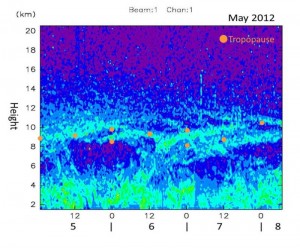The PANSY radar becomes the largest atmospheric radar in the Antarctic Full fine-resolution observations of the Antarctic troposphere and stratosphere started

The PANSY radar (Project of the Antarctic Syowa MST/IS radar, led by Professor Kaoru Sato of the Graduate School of Science, the University of Tokyo), a large-size mesosphere-stratosphere-troposphere/incoherent scatter (MST/IS) radar at the Japanese Syowa Station in the Antarctic, began operation for troposphere and stratosphere observations in May 2012 after adjustments affecting one-quarter of the entire system by the 53rd Japanese Antarctic Research Expedition. The radar is now the largest in the Antarctic, exceeding the size of the same type of radar at the Australian Davis Station. Research has now become possible into the physical mechanism of severe snow storm-inducing polar low pressure systems, and vertical exchange of minor constituents through the tropopause, which is closely related to the Antarctic ozone hole. The radar is currently gathering excellent data, and the exchange of air between the tropopause and stratosphere is becoming apparent.

Time and height section of the scattering echo in the troposphere and stratosphere by the vertical beam of the PANSY radar at Syowa Station, 5-8 May, 2012.© University of Tokyo/NIPR/Kyoto University (K. Sato, M. Tsutsumi, T. Sato)
Orange circles denote the tropopause determined by radiosonde observations every 12 hours. The scattering echo is maximized in the vertical around the tropopause and varies dynamically in time.
The PANSY radar was built at Syowa Station in February 2011 by the 52nd Japanese Antarctic Research Expedition. The team, led by Associate Professor Masaki Tsutsumi (National Institute of Polar Research), successfully began preliminary observations in March 2011, but was forced to suspend observations due to unusually severe weather conditions. The 53rd expedition, led by Professor Toru Sato (Graduate School of Informatics, Kyoto University), were unable to dock on the icebreaker Shirase for the first time in 18 years, but overcame this obstacle to complete the relocation of the antenna during the six-week summer from late December 2011. After completing the system adjustments that were planned for the winter period, the team began full observations of the troposphere and lower stratosphere.
The 54th Expedition is planning to leave for Syowa Station in November 2012 to operate the full PANSY radar system and focus on understanding atmospheric phenomena in the mesosphere and ionosphere. This is a major advance in atmospheric observational research in the Antarctic, which progresses slowly dues to the harsh environment, and will contribute to improving the predictive power and accuracy of atmospheric models.






